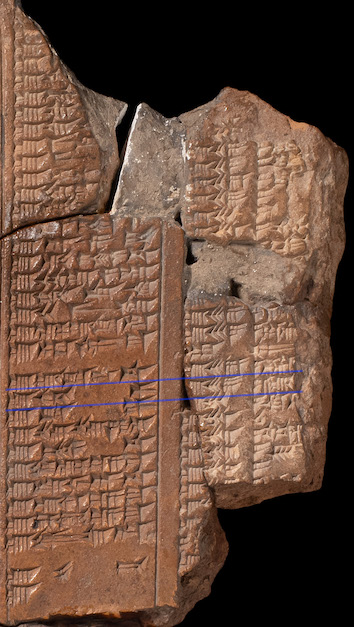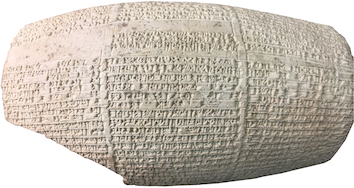Eulmaš (temple of Ištar at Agade)

Detail of K 3636+, a fragmentarily-preserved clay tablet which is inscribed with a copy of the so-called "Canonical Temple List." Eulmaš is listed as the thirty-ninth temple of the goddess Ištar. Image cropped from the photograph hosted on the eBL Project.
Eulmaš, which was dedicated to the goddess Ištar, was the principal temple of Agade, the capital city of the Akkadian state founded by Sargon (r. 2334–2279 BC) in the second half of the third millennium BC. This important building, whose foundation is generally attributed to Sargon's equally-famous grandson Narām-Sîn (r. 2254–2218 BC), remained in use long after the collapse of the Akkadian Empire and was rebuilt and renovated several times over its long history, especially in the sixth and seventh centuries BC, when it received attention from the late Neo-Assyrian kings Esarhaddon (r. 680–669 BC) and Ashurbanipal (r. 668-ca. 631 BC) and the Neo-Babylonian ruler Nabonidus (r. 555–539 BC).
Names and Spellings
Agade's principal temple went by the Sumerian ceremonial name Eulmaš, which means "House of Ulmaš." This name is attested in a variety of cuneiform sources, including lists of temples and ziggurats, literary texts (Innana's Descent into the Netherworld), royal inscriptions, and temple hymns.
- Written Forms: é-ul-maš.
Known Builders
- Old Akkadian (ca. 2340–2200 BC)
- Sargon (r. 2334–2279 BC)
- Narām-Sîn (r. 2254–2218 BC)
- Old Babylonian (ca. 1900–1600 BC)
- Ḫammu-rāpi (r. 1792–1750 BC)
- Middle Babylonian (ca. 1400–1000 BC)
- Kurigalzu I
- Neo-Assyrian (ca. 911-612 BC)
- Esarhaddon (r. 680–669 BC)
- Ashurbanipal (r. 668-ca. 631 BC)
- Neo-Babylonian (ca. 625–539 BC)
- Nebuchadnezzar II (r. 604–562 BC)
- Nabonidus (r. 555–539 BC)

BM 104738, a three-column clay cylinder with an inscription of Nabonidus recording his work, as well as that of four previous kings, on Eulmaš, the temple of the goddess Ištar at Agade. Photograph by Frauke Weiershäuser.
Building History
Although Eulmaš had a very long history, virtually nothing about its construction, decoration, and patronage is known from contemporary sources. Most of what we know comes from royal inscriptions of Babylon's last native ruler Nabonidus. Although Nabonidus mentions Sargon, the founder of the Akkadian Empire, by name in association with the goddess Ištar's temple at Agade, it was likely his grandson Narām-Sîn who was the founder and first builder of Eulmaš since a year name attributed to him (Year g) was named after the construction of that temple. No details about that project, however, are known from Narām-Sîn's own inscriptions. Since a praise of this religious structure is included in a collection of temple hymns purported to have been authored by En-hedu-ana, the daughter of Sargon, one cannot rule out the possibility that Sargon also worked on Eulmaš and, thus, was its first builder.
Ḫammu-rāpi, the most influential and powerful ruler of the First Dynasty of Babylon, also patronized this temple of Ištar. In the prologue of his "Law Code," which is best known from a stele discover in the Elamite capital Susa in modern-day Iran, Ḫammu-rāpi refers to himself as "the one who sustains the goddess Ištar in Eulmaš, (which is) in Agade, the city of broad streets and squares."
What is presently known about the history of Eulmaš after the time of Ḫammu-rāpi all comes from inscriptions of Nabonidus, Babylon's last native king. An Akkadian text written on several clay cylinders records the following details about the Ištar temple at Agade:
Because such admissions of failure are never included in Assyrian and Babylonian royal inscriptions, it is assumed with confidence that Nabonidus' workmen never discovered texts of the Kassite king Kurigalzu (probably the first ruler, rather than the second king, of that name), the late Neo-Assyrian rulers Esarhaddon and Ashurbanipal, and Neo-Babylonian king Nebuchadnezzar II making statements about not being able to find a building's foundations or using inferior materials. The direct quotations were creations of Nabonidus' scribes, presumably as part of that ruler's attempt to discredit his predecessor Nebuchadnezzar. Given the lack of contemporary sources, no first-person details about these four kings' building activities on Eulmaš are presently known.
If Nabonidus' accounts are to be believed, it took a great deal of time (three years) and effort to find the original, third-millennium-BC foundations of Eulmaš; these were presumably underneath the remains of the second- and first-millennia-BC building phases. So that future kings would have no problems locating the "true," divine-approved, original foundations of Eulmaš at Agade, Nabonidus recorded that he had the new temple built at ground level, on a high brick infill, and constructed precisely over the first foundations "not (even) a fingerbreadth outside or inside (of them)." After completing the construction of the temple's brick structure, Babylon's last native king stated that he had Eulmaš roofed with immense beams of cedar, which he had had cut down and transported from Mount Amanus, and had its doors made from a sweet-smelling white cedar. He also boasted that he had made the temple "shine like daylight." No details about the interior decoration of Eulmaš, especially its holiest rooms, are known.
Archaeological Remains
Since the exact location of Agade, the capital of the Akkadian state founded by Sargon (r. 2334–2279 BC), is not yet known, the archaeological remains of Eulmaš are yet to be discovered.
Further Reading
- Frame, G. 1993. "Nabonidus and the History of the Eulmaš Temple at Akkad," Mesopotamia 28, pp. 21–50.
- George, A.R. 1993. House Most High: The Temples of Ancient Mesopotamia (Mesopotamian Civilizations 5), Winona Lake, p. 155 no. 1168.
- Jursa, M. 1996. "Akkad, das Eulmash und Gubāru," Wiener Zeitschrift für die Kunde des Morgenlandes 86, pp. 197–211.
- Weiershäuser F. and Novotny J. 2020. The Royal Inscriptions of Amēl-Marduk (561-560 BC), Neriglissar (559-556 BC), and Nabonidus (555-539 BC), Kings of Babylon (Royal Inscriptions of the Neo-Babylonian Empire 2), University Park, p. 8.
Jamie Novotny & Naomi Weir
Jamie Novotny & Naomi Weir, 'Eulmaš (temple of Ištar at Agade)', Babylonian Temples and Monumental Architecture online (BTMAo), The BTMAo Project, a sub-project of MOCCI, [http://oracc.org/btmao/Agade/Eulmash/]